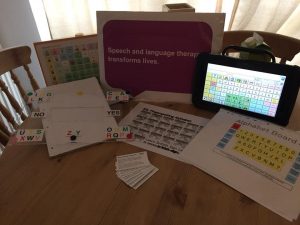I was recently doing some reading around to see how long people have been reporting on foreign accent syndrome (FAS) and related matters. I came across a case reported by Jonathan Osborne (1794-1864). He was a Dublin physician, professor of materia medica and surgical pioneer. He reported a case of speech after stroke in the Dublin Journal of Medical and Chemical Science, November 1833. The case was interesting from the point of view of my FAS searches, and wider studies in aphasia, but also had an added angle from the point of view of evidence based practice (EBP). We smugly sit here in 2016 thinking EBP is a recent ‘invention’, forgetting that we wouldn’t be where we are today if people in the past had not been practising it already. So, first a bit on Osborne’s case, then a little light on his therapy practices.
His description is of a 26 year old male, proficient in French, German, Italian, Latin and English and planning to take up medical training. A year prior to Osborne meeting him he had been staying up in the country. He was taking his breakfast after his usual morning swim in the local lake. During breakfast he suffered a stroke (the term then was apoplectic fit). A doctor was summoned. He was bled; and after being ‘subjected to the appropriate treatment’ became ‘restored to his intellects’ after about two weeks. Unfortunately he ‘had the mortification of finding himself deprived of the gift of speech’. He had no paralysis and spoke a variety of syllables fluently, with apparent ease. His speech though was incomprehensible.
To those unaware that he had suffered a stroke, it sounded as if he were talking in a foreign tongue. When he arrived back in Dublin his jargon caused him to be taken as a foreigner in the hotel where he signed in. When he went to Trinity College to visit his friend he was unable to convey whom he wanted to visit to the gatekeeper. He was only able to point to the flat where his friend had lived.
When he came under the care of Osborne he is reported to have been able to understand everything said to him. His written language comprehension was fine – he continued to read the newspaper daily and indicated correctly when tested on the content. His written output was fluent, ‘the words being orthographically correct, but sometimes not in their proper places’. He wrote correct answers to historical question and translated Latin sentences accurately and reported on medical tracts in French.
Arithmetic was accurate too and he could still play a good game of draughts. As Osborne had no knowledge of his pre-stroke musical abilities he was unable to test this in informed detail. The gent could nevertheless remember the tune of ‘God save the king’ (the whole of Ireland at the time was an English colony) and pointed to the ships on the river when played ‘Rule Britannia’.
Alas, despite all this, his spoken output was severely impaired, even though it appeared from efforts to self-correct that he knew his output was errorful. His repetition was confined to uttering certain monosyllables. A range of consonants in isolation were beyond him, even though on trying to utter one he would produce another he had not been able to speak a moment ago.
Osborne gave him some sentences to read aloud – not what today would be a standard aphasia passage – he used an excerpt from the Bylaws of the College of Physicians. Osborne transcribed what he heard — an early endeavour to phonetically transcribe disordered speech after stroke. His rendition of the sentence ‘It shall be in the power of the College to examine or not examine any Licentiate, previously to his admission to a Fellowship as they see fit’ was transcribed by Osborne as ‘And the be what in the tomother of the trothertodoo to majorum or that emidrate ein einkrastrai mestreit to ketra totombreidei to ra fromtreido asthat kekritest’. A repeat reading a few days afterwards elicited: ‘Be mather be in the kondreit of the compestret to samtreis amtreit entreido of deid daf drit des trest’.
Osborne speculated that a principal factor associated with the man’s jargon was his polyglot status – pointing out that several of the syllables here have a distinct German flavour. His speech output apparatus was unable to stably focus on one language, but ranged amongst them all.
This of course is a possible ingredient, but is unlikely to have been the prime factor. It is more likely that he presented either with what nowadays we might term apraxia of speech, conduction aphasia or phonological jargon. These do not require that someone speaks more than one language for them to arise. Certainly in the case in FAS the diagnostic marker is that the accent arises de novo and is not associated with another language which the person speaks, or has spoken. Osborne’s account of how this man was mistaken for a foreigner does, though, illustrate the power of the perceptual impression of the listener to read into a situation a dimension which is, in objective terms, not there.
C.S. Breathnach claimed in an article on the Irish Journal of Medical Science in 2011 that this was definitely conduction aphasia (principally focusing on the poor performance to repetition). Osborne does not offer sufficient detail to clinch a definitive diagnosis or differential diagnosis, so Breathnach’s conclusions are not that strongly supported.
The patient was given the interventions of the day for apoplectic seizures: repeated applications of leeches, a succession of blisters to the nape and occiput, mercurial purgatives and shower baths every morning. But to no avail. Based on his systematic, longitudinal investigation of what the man was, and was not able to accomplish by way of speech, Osborne was able to show that these interventions were unlikely to and did not affect the underlying speech problem.
Instead he prescribed actual speech therapy, basing it on revolutionary thinking for the time, that speech and language were separate processes, that the man did not have ‘loss of memories’ for words because he could not speak them (how could one speculate he had lost the memories of Latin words if he could correctly understand and translate them, Osborne argued). Accordingly therapy focused on actions and capability of ‘performing by means of his voluntary muscles’. He prescribed systematically built up drills (largely following the presumed order of acquisition in childhood) to re-establish basic movements for speech sounds, aiming to make them once more automatic, fluent, ‘with a rapidity almost equal to that of thought’. He also explained how his therapy focused on utterance initial recall and accuracy and what we might nowadays term using alternative routes to activation. He drew the analogy of a musician who cannot access a tune, but having been aided with the first notes his retained learning takes over. Thus his therapy aimed for the ‘faculty of setting the machinery of speech to the beginning of the sentence, trusting to the peculiar memory depending on associate objects for its continuance, and releasing him from the care of pronouncing the individual syllables of which it is composed’.
Given the later clearer transcriptions of the College regulation sentence in Osborne’s report, the therapy appeared to afford great strides forward. ‘It may be in the power of the College to evhavine or not, ariatin any Licentiate seviously to his amission to a spolowship, as they shall think fit’. No doubt cessation of the other treatments may have had a hand in progress too!
A fascinating case from many points of view – but made interesting by the level of detail Osborne was able to proffer on several levels. There is, for the age, a serious attempt to describe the strengths and weakness of the man’s impairments. There is the discussion of his therapeutic reasoning in why the purgatives and so forth would not affect language and a reasoned argument for his alternative methods (supported additionally with data from reports of cases from head injury in the battle of Waterloo). His advocacy of separation of speech and language, of circumscribed lesions associated with specific impairments anticipates by several decades the studies that today are celebrated as establishing these facts. It was a long time before writers reported data from their assessments and conducted longitudinal follow up. Finally, this may be a first report of systematic, explicit, theory based treatment for speech output problems after stroke.
Nick Miller




